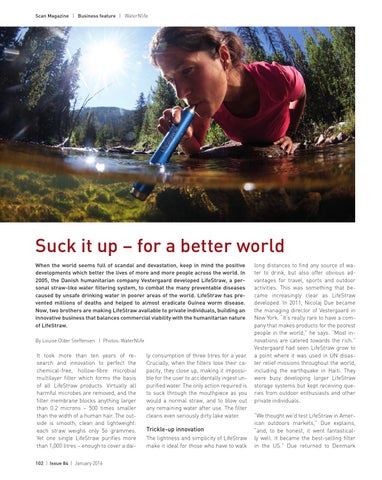Scan Magazine | Business feature | WaterNlife
Suck it up – for a better world When the world seems full of scandal and devastation, keep in mind the positive developments which better the lives of more and more people across the world. In 2005, the Danish humanitarian company Vestergaard developed LifeStraw, a personal straw-like water filtering system, to combat the many preventable diseases caused by unsafe drinking water in poorer areas of the world. LifeStraw has prevented millions of deaths and helped to almost eradicate Guinea worm disease. Now, two brothers are making LifeStraw available to private individuals, building an innovative business that balances commercial viability with the humanitarian nature of LifeStraw. By Louise Older Steffensen | Photos: WaterNlife
It took more than ten years of research and innovation to perfect the chemical-free, hollow-fibre microbial multilayer filter which forms the basis of all LifeStraw products. Virtually all harmful microbes are removed, and the filter membrane blocks anything larger than 0.2 microns – 500 times smaller than the width of a human hair. The outside is smooth, clean and lightweight: each straw weighs only 56 grammes. Yet one single LifeStraw purifies more than 1,000 litres – enough to cover a dai102 | Issue 84 | January 2016
ly consumption of three litres for a year. Crucially, when the filters lose their capacity, they close up, making it impossible for the user to accidentally ingest unpurified water. The only action required is to suck through the mouthpiece as you would a normal straw, and to blow out any remaining water after use. The filter cleans even seriously dirty lake water.
Trickle-up innovation The lightness and simplicity of LifeStraw make it ideal for those who have to walk
long distances to find any source of water to drink, but also offer obvious advantages for travel, sports and outdoor activities. This was something that became increasingly clear as LifeStraw developed. In 2011, Nicolaj Due became the managing director of Vestergaard in New York. “It’s really rare to have a company that makes products for the poorest people in the world,” he says. “Most innovations are catered towards the rich.” Vestergaard had seen LifeStraw grow to a point where it was used in UN disaster relief missions throughout the world, including the earthquake in Haiti. They were busy developing larger LifeStraw storage systems but kept receiving queries from outdoor enthusiasts and other private individuals. “We thought we’d test LifeStraw in American outdoors markets,” Due explains, “and, to be honest, it went fantastically well. It became the best-selling filter in the US.” Due returned to Denmark
